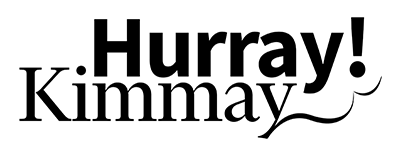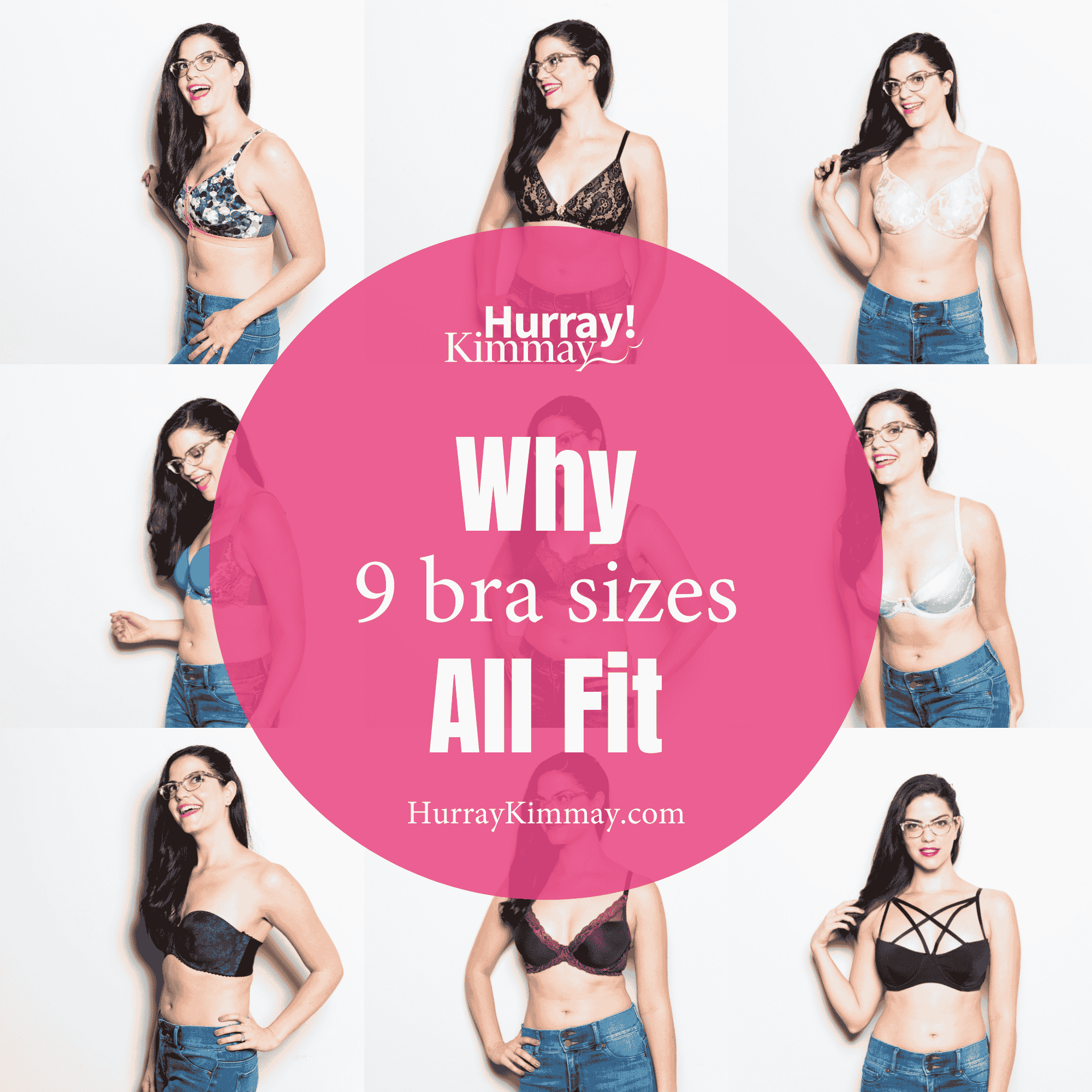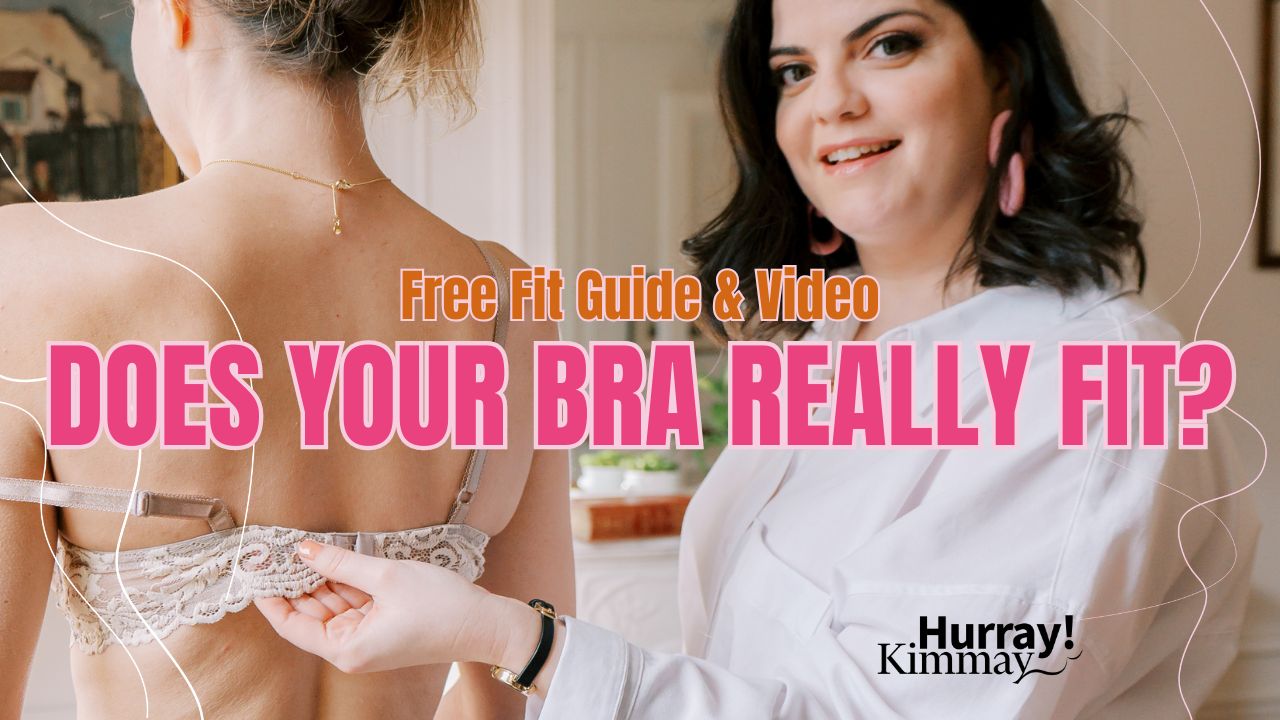Note from Kimmay: This post was originally posted in 2016 and it is my most popular blogs that has led to an array of opportunities, so we made some slight updates in 2024. Enjoy!
One of my least favorite questions I get as a bra fitter is: “Can you measure me? I just want to know my size.” Sorry, friend, it doesn’t work that way. Not if you want to say hurray.
Here’s proof: I recently took photos of me wearing 9 different bra sizes that each fit. On the same day. Yep. And to be honest, there are probably more sizes I could have worn (but I wanted to keep things from getting TOO out of hand, here.)
Since starting bra fitting in 2005, the biggest complaint I get from bra wearers, bra designers, bra retailers, bra fitters, bra bloggers, and even bra haters is: how can I confidently know (or tell someone else) what size to wear?! Ok, take a seat and a deep breath because the truth is: there isn’t an easy way. I know. I’m sorry. Truly, I am. This is actually the kind of lingerie industry issue that keeps me up at night. For real! I wish I could help lovely people like you navigate a department store or boutique filled with bras from many brands in many sizes, styles, and materials with ease and a simple three step process or a quick video on how sizing works. But that is not the case. You could, alternatively, learn all the ins and outs of bra brands, sizing, and fitting techniques. Knowledge is power, after all. But realistically, unless you’re a professional bra fitter and lingerie nerd like yours truly: who has time for that?!
So I’m working hard for you. I’m being honest that the bra industry and how sizing works is not perfect and can be difficult to navigate. I’m also here to help you take some of the mystery out of bra sizing and finding a good fit. And the first step is understanding why in the world so many bra sizes can even fit in the first place. Trust me, a little bit of understanding will go a long way. And in this case, going a long way means stepping toward saying hurray inside, outside, and underneath.
In this blog article, you’ll find out why I can wear 9 different bra sizes, how to find a starting point for your own size, and how to determine if your bra even fits. Hurray! Let’s get started.
The images in this blog post were taken all on the same day, and I used the same fitting points for each one. As in, I made sure the band, cups, underwire (if there was one), and straps all fit well and felt great. You can learn more about my criteria for a good fit, and use the same bra fit tips I use for yourself, too.
Resources:
- Free Class and Bra Fit Guide (HurrayKimmay)
- Find Your Bra Starting Points (HurrayKimmay)
- Bustle LIVE bra fitting Q&A (Facebook Video)
At the time of the photos, my measurements were:
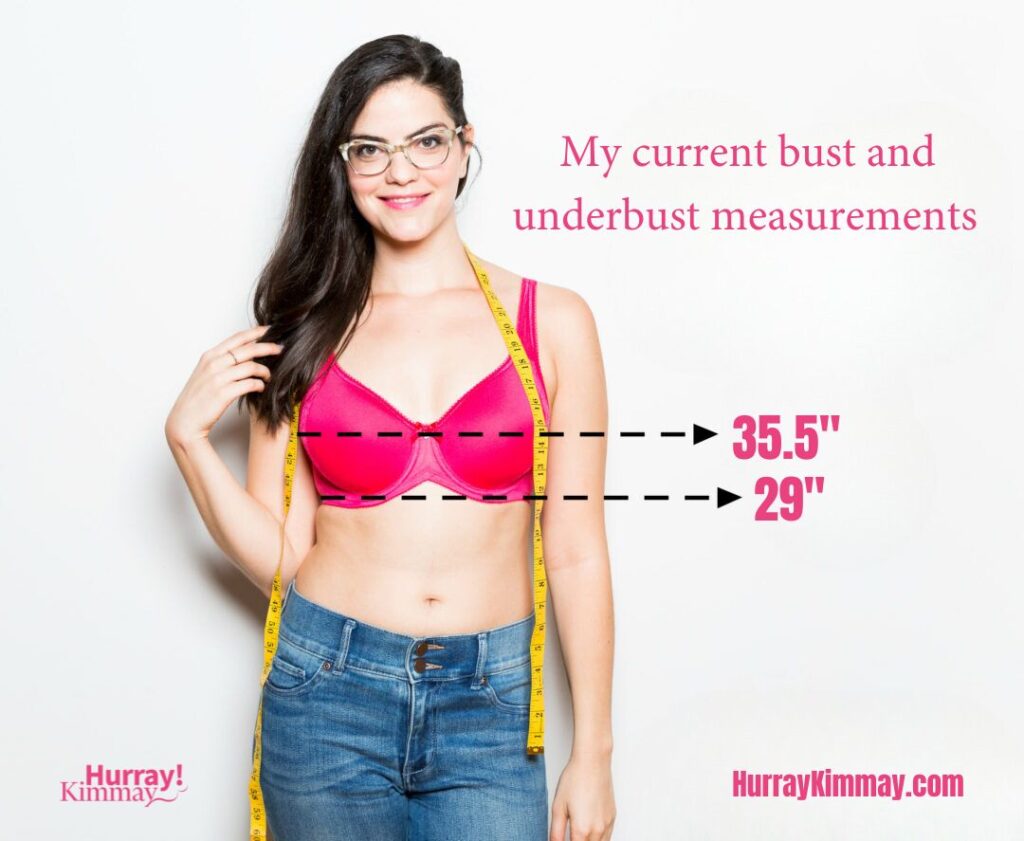
- Bust: 35.5″ (around the fullest part of my bust and torso)
- Underbust: 29″ (around my torso, just underneath my bust)
To get to my bra size starting point, I used a really simple calculation. Get the instructions for how to do it yourself in this article on how to find your bra size and get my free fit guide here.
Band: Based on my measurements, I added 0-3 inches to my underbust and got: 30 or 32.
Cup: Then I used the first band size and subtracted that from my bust measurement for 5.5. If 1 inch is 1 letter, that lead me to A, B, C, D, E (and a half).
So, that means my starting point is between a 30DD/E and 30DDD/F. True! And if I wear a 32, because of sister sizing (see below), I would be in between a 32D and DD/E. Confused already? Keep reading – it gets clearer.
Resources: Find Your Bra Size Starting Points (Hurray Kimmay)
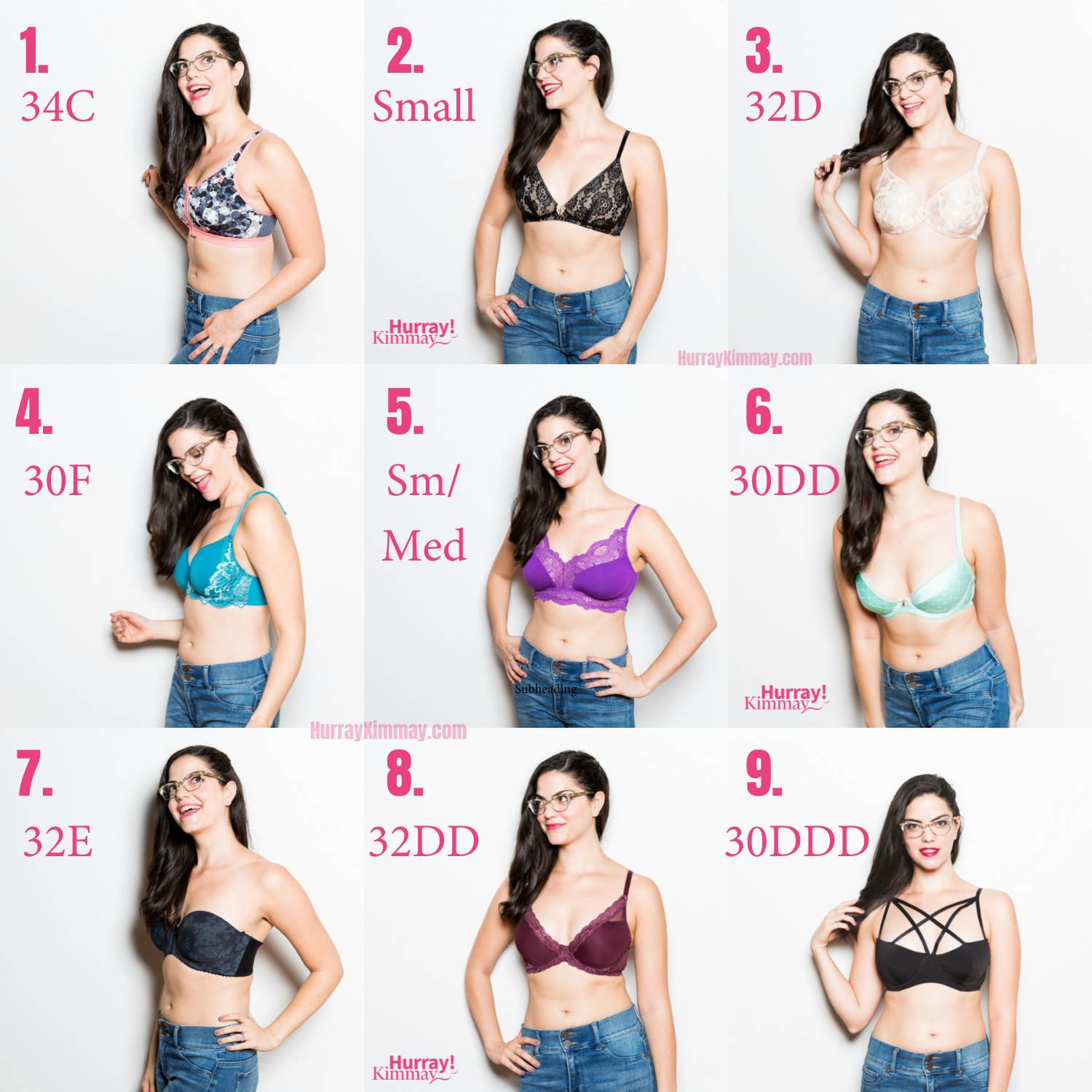
The bras above: 1. Shock Absorber 2. AnaOno 3. Wacoal 4. Simone Perele 5. Fleur’t 6. Tutti Rouge 7. Prima Donna 8. Natori 9. Adore Me
Though I have my starting size, here are the sizes that all fit me on this day:
- Small
- Small/Medium
- 30DD
- 30DDD
- 30F
- 32D
- 32DD
- 32E
- 34C
Yeah, that’s a lot. So here’s the deal. Here is why it’s totally normal that several different bra sizes can fit you well.
Brands label their sizes differently
Most brands label their bras using a number and a letter. Some just use small, medium, large, etc like it #2. And a few even have different combination sizes, like #5, or completely different sizing all together. For those that use the number and a letter, the number refers to the underbust measurement, and the cup responds to the bust measurement.
Now here’s where it gets crazy. Depending on what country makes the bra, the sizing can be labeled in a very different way from brand to brand. That’s why you may see more than one size on the same bra. They’re letting you know the conversion across countries. For example, the band in the USA is a 34, and in Europe is a 75. Also, cup sizes are sized differently across several countries. That’s why I’m wearing a 30DDD in #9 and a 30F in #4 (which are possibly the same cup size), and a 32DD in #8 and 32E in #7 (which are certainly the same cup size). I say “possibly” and “certainly” because there’s a bit of a disagreement – even between lingerie brands and long time bra fitters – on exactly how to convert some of the cup sizes.
Each brand fits differently
Because there are no real sizing standards across the world, each brand makes their own designs and patterns. That means that a 34C in one brand can fit completely different from a 34C in another brand. It’s similar to jeans or shoes – a size 28 or 8 in one brand can be slightly tight or loose depending on the way that brand designs. In fact, I feel it’s even more of a range in the bra world. That’s why I own two to three different jeans sizes and at least nine different bra sizes. (Also, full disclosure: I’ve found only two brands of jeans that fit and way more than nine different bra brands that fit. If anyone does what I do for bras but for jeans, please let me know. Immediately.)
Additionally, brands create patterns using different sizing methods. Some use a “plus four method”, meaning the size on the label is four inches more than a woman’s actual underbust measurement. Other brands use a different pattern, and then label their bras with zero to three inches more than a woman’s actual underbust measurement. There’s actually a lot of arguments about which is correct, and an entire movement about this. I’m not kidding.
Different styles fit differently
There are many different bra styles out there. From minimizers to plunge to demi to push up and it goes on and on and on and on. Depending on the cut, style, or coverage, a bra style can fit so differently. This may affect the size you wear in that style. For example, I wear a 32D in #3 above because it’s full coverage, while I wear a 32DD in #8 because it’s a plunge and has less coverage. These also happen to be different brands, but even in the same brand you can wear different sizes if the style is totally different.
You can’t go into a department store just with your size and take something of the rack. Just like jeans you need to try on the bra and check to see what size fits you best in that particular cut and style.
Each material fits differently
One of the reasons that the “plus four” method may or may not work any longer, is because the materials we use to create bras has changed. Back in the day, bras had little to no stretch. Now, elastic and thinner, lighter materials make them stretchier. That means that to get a snug band and firm support, you may need to size down in a bra that has more stretch. And you may be able to wear a bra with a larger band size if it’s made of firmer materials. A great example of this: sports bras. Because they are usually made with very thick, firm, non-stretchy materials I usually size up in the band. That’s why I’m wearing a 34C in the sports bra in #1 and a 30F in the bra in #4.
Sister Sizing
Because each bra fits differently, there’s some trial and error involved in finding the right fit. If you need to adjust your cup, you can go up or down using the lettering system. However, when you adjust your band, things get more involved. That’s because your cup size is based on your band size. In other words, the size D means nothing really unless we know what band size we’re talking about. Therefore, a “sister size” is the bra size up or down a band size, with the new cup size measurement. Example: a 34C and 32D. The 34 band is one size bigger than a 32. However, because the cup size is relative, the C in a 34 is actually same volume as a D in a 32D. That’s why I didn’t adjust from a 32D to a 30D or 34D, above. When I changed the band size, I changed my cup size, too.
Body Changes
Keep in mind that I took these photos and wore these bras all on the same day, within just an hour or so of each other. That means there was little to no difference in my measurements and body. But let’s be really frank: our bodies change all the time. Due to your period and hormones, or weight gain or loss, your bra size and what fits best can change pretty drastically in the same month. In fact, I often wear a bra with a fuller cup or a whole cup size up when I’m expecting my cycle. Totally normal. I promise.
PS: There is a bonus in my Bra Confidence and Comfort course on navigating body changes. Anyone who wants to make a loving and informed choice about what to wear on their body each day is welcome to join!
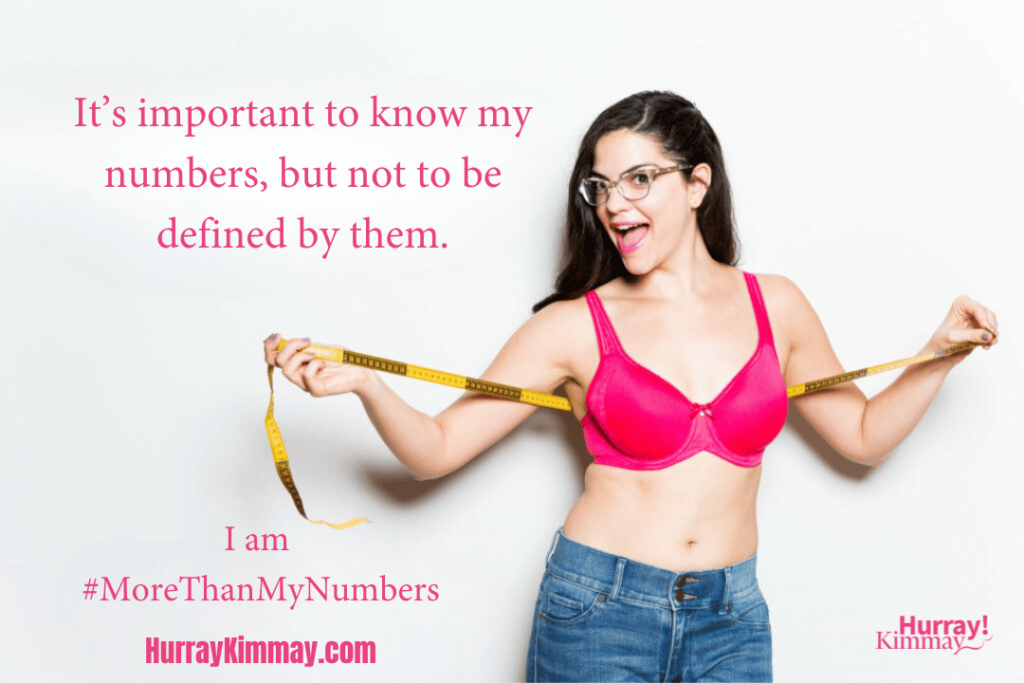
Here’s what this all means for you
- It’s important for you to know the basics, and it’s OK to not know everything. I’m a firm believer that working with a great bra fitter is the best way to go from nay to hurray. Bra fitters have lots of experience with different brands, styles, materials, and women’s bodies. If they’re good, they can easily navigate the vast land of bras and suggest styles that will work best for you. And if they’re really good, they’ll also teach you about the fit of each, how to care for your bras, and which bras to wear with what clothing. That being said – knowing the basics of what to look for in a good fit is important whether you’re going it alone or working with a pro.
- Your bra size is just a number (and maybe a letter), and it does not define you. There are several different sizes that can fit you, after all. Never just one. And quite frankly, you are more than a number.
- Measurements are a starting point. Knowing your underbust and bust measurements is super important. First, they’ll give you a clue into your current body stats. And you can use them to calculate your bra size starting point, or what my colleague, Elisabeth Dale, calls knowing your “bra zone“. So go on, take your measurements and calculate YOUR bra size starting point!
- Measurements can’t tell you the whole situation. Even if you take five or ten measurements, or use a quiz, or a special calculator. Because the truth is that even with more information, every bra fits differently. That’s where fit knowledge and trial and error come in. And measurements, just like any number, don’t tell the whole story. You, your breasts, and your body, are not your numbers.
The whole point here is that your bra size is not just one size that a bra fitter can tell you, and then you can magically purchase from any store or online retailer and expect to fit. And more importantly, that means the “label” that comes with your bra size need not apply. You are not D cup. A D cup in this particular brand, band size, and style may fit you best today in this bra… but that is not “you”. The reason this is all so important is because I typically hear women in the bra fitting room define themselves by the number and the letter on their band. When we let something define us, it pigeon holes us into something. And not usually into something very nice.
In my many years of unscientific research, here is what I’ve heard women most commonly say about their cup sizes:
- The smaller your band size, the better. Because that means you’re thinner. Keep in mind, because cup size is relative to band size, then that means that the smaller the band, the higher the letter… which then results in this:
- If you are an A cup or have small breasts, you are smart, athletic, not very sexy, prude, boring, straight laced, mannish, serious, more brains than beauty
- If you are a B or C cup you are: normal, down the middle, average, basic, on the right path, one of the good ones, correct, right, just as you should be, boring
- If you are a D or DD you are: big busted, more than average, sexy, coveted, too much
- If you are over a DD you are: sloppy, fat, oversexed, loose, a slut, oozing with femininity, curvy, pin up, Dolly Parton, too much to handle, a freak
- No breasts (mastectomy) means you’ve lost all of your femininity. Period.
These are just stories. None of these things – the good or the bad – are really even true. They’re just what we made up. And those letters and numbers do NOT define you. It makes me sad to watch a gorgeous, kind, smart, sensitive woman walk into a fitting room and use the numbers and letters of her bra to define her. It’s been my pleasure to help her see that she is more than a number and a letter. That she doesn’t need to fear the tape measure. And that includes you and me.
Your turn: I encourage you to let go of the stigma with your numbers. Take your measurements but don’t be defined by them. And, help me encourage women to let go of their numbers, too. I’ve created a campaign and a movement to help women like you say I am #MoreThanMyNumbers. You are not your measurements, your bra size, your weight, your age, your zip code, your number of kids, your number of lovers, or any other number. You are a vibrant, complex, amazing woman. You are you.
Free Fit Guide & Video
Want to wear a bra without ripping it off at the end of the day? Watch Kimmay’s video tutorial on getting a comfortable fit, plus a free printable guide and check list to take shopping. Don't spend another minute feeling uncomfortable in your bra.
The More Than My Numbers project is about knowing and understanding our numbers is helpful, and sometimes important. It’s so wise not to ignore them or dismiss them. And. They are not the whole story, especially when it comes to bras. They only provide some information so you can make a loving and informed decision about what to wear right over your heart. With our first shoot in 2016 and second in 2017 as well as workshops, blog posts, and dozens of national and international press mentions (including a radio interview on the BBC in the UK!) this project blossomed and grew. Several brave women and I bared our bodies and our souls, encouraging folks to use numbers as information, not a definition.

PS: The photos in this post, as in every post, are not airbrushed, photo shopped, or edited to alter my body or face in anyway. I truly believe that all bodies are beautiful, and don’t need to be altered to say hurray! Photos were taken by the lovely Corrine Louie.
The bras in this post were either purchased by me, or given as a gift by the brand. This is not a sponsored post and no brands in the above images paid for placement.
